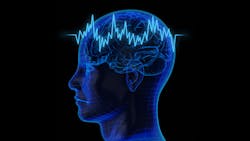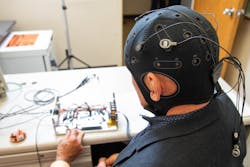Next-Gen EEG Could Help Recover Lost Brain Functions
A device being development at the SLAC National Accelerator Laboratory and Stanford University could return lost brain functions to patients by measuring how their brains respond to electrostimulation therapies.
The approach could open new avenues for treating brain disorders and selectively switching brain activities on and off, says Anthony Norcia, a professor of psychology at Stanford who initiated the project.
Neurostimulation via electrodes placed on the scalp shows a lot of promise, but its immediate effects are hard to study because the brain’s neural response are swamped by the million-times-stronger pulses researchers send into the brain. To detect the much-fainter brain responses, scientists had to monitor brain waves and behavioral response in separate sessions before and after stimulation. The new device measures brain waves at practically the same time the stimulus is applied, potentially establishing a much better link between the two.
“The device works like radar, which sends out electromagnetic waves and passively listens for the weaker reflected waves,” says SLAC senior scientist Christopher Kenney. “Here, we send electrical pulses into the head via the electrodes of an EEG monitor, and in the time between those strong pulses we use the same electrodes to detect much weaker electrical signals from inside the head.”
The brain is an intricate network of hundreds of billions of neurons, and anything that interrupts this network—such as abnormal brain development or a stroke—can cause severe disorders, including epilepsy, depression, anxiety, visual impairment, chronic pain, and paralysis.
Researchers at SLAC and Stanford are developing a device for non-invasive therapies that bring back lost brain functions by electrically stimulating the brain. (Dawn Harmer/SLAC National Accelerator Laboratory)
Stimulating brain tissue alters the way neurons fire and helps the brain form neural connections.
Norcia’s research focuses on applying the method to cases of visual impairment, such as amblyopia (lazy eye) and strabismus (crossed eyes). It also facilitates a better understanding of phenomena like binocular rivalry, which describes the fact that when presented with two different images at the same time, we can only be aware of one at a time.
Norcia’s group develops models that describe how electrical activity from the brain’s visual centers radiates to the scalp, where it can be picked up and measured by an EEG. It also develops models for delivering electrical pulses to specific locations in the brain, where they alter brain function associated with vision.
“Our models give us a pretty good idea for how to design an array of electrodes to reach specific volumes inside the head,” Norcia says. “But we also want to be able to ‘listen’ to the brain’s response at the same time to determine whether an applied stimulus had the desired effect.”
Doing so simultaneously isn’t possible with today’s clinical EEG machines, but that may soon change, thanks to the work done at SLAC.
“At SLAC, we’re trying to answer some of the really big questions about our universe, and figuring out how the human mind works seems to be right up there,” Breidenbach says. “We certainly have the engineering skills and resources to help with some of the technical issues in neuroscience. With our background in high-energy physics, we’re also used to multidisciplinary collaborations and know how to make them work.”
About a year after the project received funding through Stanford Bio-X, the team successfully tested a prototype for an EEG machine that delivers electrical brain stimulation while simultaneously measuring the brain’s activity.
To do so, the researchers paired the electronics board of a conventional EEG monitor with another they built that delivers electric stimuli generated with 9-V batteries. Then they successfully tested the device on themselves.
More work needs to be done before studies on a larger group of people can begin. For example, future versions of the device will have more electrodes and will provide more control over how pulses are delivered.
“Right now, we can switch stimuli on and off and set their intensities and durations,” says SLAC’s Jeff Olsen, an electrical engineer on the project. “In the next generation, we’ll be able to program the device, which will let us choose different types of signal shapes and synchronize electrical signals with other external triggers, such as visual stimulation.”
But the team’s plans don’t stop there.
“In the long run, we would like to develop a device on a chip that would make neurostimulation available to patients wherever they go,” says Kenney.


